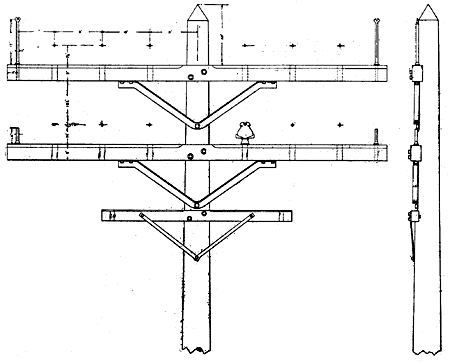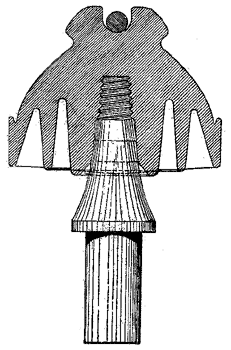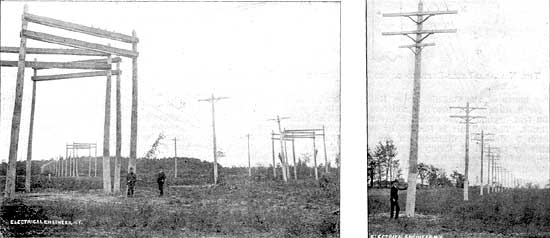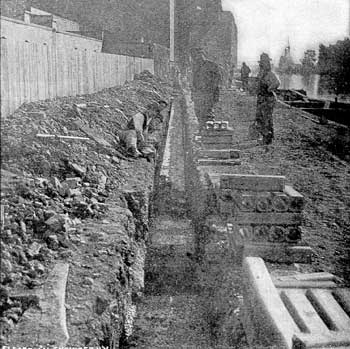[Trade Journal]
Publication: The Electrical Engineer
New York, NY, United States
vol. 22, no. 443, p. 413-415, col. 1-2
POWER TRANSMISSION
TRANSMISSION OF NIAGARA POWER TO BUFFALO
BY ORRIN E. DUNLAP
The progress that has been in the construction of the Niagara-Buffalo power transmission line is such that it cannot fail to be satisfying to even such an anxious people as the residents of Buffalo. The contract for the work is held by the White-Crosby Company, who have as their superintendent Mr. John A. Wilson, with is office in North Tonawanda. Under the efficient supervision of Mr. Wilson, the transmission line has been built with truly wonderful rapidity, and to-day it stands as another connecting link between the Queen City of the Lakes, Buffalo, and the Power City of the World, Niagara Falls.
For nearly twenty-six miles this link of copper stretches in its brightness through city and village and across country, and as there are three conductors, or one three-phase system, the total length is nearly seventy-eight miles.
Starting from the transformer building on the east side of the Niagara Falls Power Company's central power station, the transmission line extends along the northerly side of Adams avenue on the power company's property to a point one and one-half miles east of Sugar street, where it leaves Adams avenue, and runs along the west side of and adjacent to the right of way of the Niagara Junction Railway. It then runs to a point about 500 feet north of the Mile Line road, where it turns at right angles and runs nearly due east through the power company's land and through private property to a point about one mile north of La Salle. From this point it runs along adjacent to the old mile line survey all the way to Tonawanda Creek, following, in general, the old line established as far back as 1798 and re-established for this purpose by surveys, old maps, notes and persons and by a new map filed in the county clerk's office in Lockport.
The line crosses the Tonawanda Creek at or near Division street, in the village of North Tonawanda, and then passes in a southerly direction across the right of way of the proposed Buffalo, Thousand Islands & Portland Railroad to Ellicott Creek, while it crosses, and continues in a southerly direction over private property to the south line in a westerly direction for about a mile and a quarter, then crosses private property in a northwesterly direction to the east bank of the Erie Canal, which it strikes near the foot of Hinds street, in the village of Tonawanda, and for the remaining distance to Buffalo it extends along State property, the canal bank, on the east or heel path side. The pole line ends about 300 feet north of Brace street, in the city of Buffalo, at which point the conduit work commences, and for the last 4,200 feet the cables will be laid underground.
Throughout its length the transmission line runs for nearly eighteen miles through private property, a right of way 30 feet wide having been purchased by the Niagara Falls Power Company. Two and one-half or three miles of the line is built within the limits of the city of Buffalo, and about five miles of it along the bank of the Erie Canal, the right of way for which was obtained through the franchise granted by the State to the Cataract General Electric Company, this being the first construction going to show how widely beneficial the granting of this franchise is likely to be, not alone to the canal, should electricity be adopted as the motive power thereon, but to many villages and cities throughout the State. In its route the transmission line passes through the City of Niagara Falls, the town of Niagara, the town of Wheatfield, the village of North Tonawanda, the village of Tonawanda, and also through a small portion of the city of Buffalo. These places are located in Niagara and Erie counties, which naturally will receive the greatest benefit from the Niagara power development and transmission.
| |||
| The Niagara-Buffalo Power Transmission Line. - View Showing Construction at Points of Transposition, Curves and Straight Run. |
The construction of this transmission line has been a task of no small magnitude. Work was commenced on August 14, and nearly 200 men put to setting poles. In all, there were six gangs at work on the pole erection, two of which worked from the Falls toward Tonawanda, two from Tonawanda toward the Falls and two from Tonawanda toward Buffalo. In length the poles vary from 35 to 65 feet. They are of white cedar, shaved, and have all been placed in position. In order to facilitate the work, the poles were shipped to North Tonawanda, La Salle and Niagara Falls, and when the construction was along the canal a boat was used, the White-Crosby Company having a steam tug and a naphtha launch on the work to transport men to and from the scene of their labors. These boats were kept at Tonawanda, the canal being used in the run toward Buffalo and the river for trips down stream.
One of the illustrations accompanying this article portrays the manner in which the conduit was constructed along the bank of the Erie Canal in Buffalo. Starting in the rear of the power house of the Buffalo Street Railway Company, it extends for a distance of nearly 4,200 feet north to a point about 300 feet beyond Brace street, where the terminal house will be built. The conduit is formed by twelve vitrified tile ducts, each 3 inches in diameter in the clear. These tiles were made by the H. B. Camp Company of Greentown, O. They are laid in concrete with 4 inches as the minimum protection on all sides. Three of the ducts will be sufficient to carry the cables first laid, but with their usual foresight the Niagara Falls Power Company are making provision in this construction for twelve cables. The depth of the conduit trench is about 40 inches, but this was governed somewhat by the conditions met with, the average depth of the soil covering over the conduit being about 18 inches. In no place does the conduit approach the edge of the canal bank nearer than 14 feet, its inside line holding close to the 16-foot mark.
| |||
| The Conduit Section Along the Canal. |
In all, there are about sixteen manholes along the line of the conduit, their location being governed mainly by the condition of the locality. These manholes are octagonal in form, with an interior of 5 feet. They have a brick wall of 12 inches, the bottom being formed by 6 inches of concrete and one layer of brick. In the construction of the conduit the surplus earth was loaded onto scows and carried out into the river and dumped. The terminal house will be of brick, with an interior of 16 by 9 feet and a height of 22 feet. From the last manhole in the conduit to the terminal house there will be a short tunnel about 4 feet long. The anchorages of the cables will be on the poles outside.
The cable to be laid in the conduit will be lead-covered and furnished by The Safety Insulated Wire and Cable Company, of New York, under strong insulation guarantees. This cable will have a conductor equal to 350,000 c. m., and aggregates 12,345 feet in length for the three circuits. The rubber insulation is 9/32 inch thick, covered with rubber tape. The lead sheath has a thickness of 7/64ths inch, and contains 3 per cent of tin. Tests of the cable on the ground showed it to be capable of withstanding 40,000 volts without injury. This lead cable will be carried out as far as the first pole, the distance probably being about 20 feet, and there it will be connected with the bare copper cable of the pole line. The terminal house will be equipped with lightning protectors.
The transformer house at the Buffalo end of the line will be 16 by 20 feet inside and located in the rear of the Buffalo Railway Company's station. It will be almost entirely below ground, and in it will be placed the static transformers, the rotaries to be located on the power house floor, it is understood. The electrical equipment of this line, it will be recalled, will be supplied by the General Electric Company.
The illustrations present herewith give an excellent idea of the headway made and of the manner in which the pole line is constructed, but do not show it in its finished state. In securing the right of way over private property many difficulties were encountered, all of which were met and overcome by the remarkable determination and energy of the Niagara Falls Power Company, with the result that the route selected is quite direct in its general line. In some cases farmers were loath to divide their farms by selling a strip 30 feet wide at or near the center, and this forced the line to the borders of some of the farms, causing some circuitous places, as will be seen by the illustrations. Then, again, the route of the proposed Buffalo, Thousand Islands & Portland Railroad, as well as other railroads, had to be crossed.
The poles are set at a depth of 6-1/2 to 8 feet, and where soft soil was met they were set in concrete. For the main, however, they are placed right in the ground and thoroughly well tamped, the soil being of very hard clay. In fact, it is stated, that the men found the work of excavating for the poles very hard, the clay being exceedingly firm. The poles are set to the east side of the center of the right of way, the outside line of the 30-foot strip being 1 foot beyond the end of the outside line of the large crossarms. The two top crossarms are 12 feet long by 4-3/4 by 5-3/4 inches, and made of yellow pine. Both of these crossarms are designed for power conductors. They are supported by braces made of 2 by 2-inch angle iron. The lower or telephone line crossarms are 6 feet long by 3 1/4 by 4 1/4 inches. They are supported by 1 1/2 by 1/4-inch iron braces. The crossarms are all staggered, the gains being painted before the arms are set. Where double crossarms are used at corners and other angles in the line, they are fastened by 3/4 by 10-inch lags and 3/4-bolt through all parts. All poles set at angles will be guyed by a 3/4-wire strand and turnbuckles to the bottom of the opposite pole.
 |
| The Niagara Falls-Buffalo 20,000 H. P., Three-Phase Transmission Line. |
The line conductors consist of nineteen-strand cables, each of 350,000 c. m., and furnished by the American Electrical Works of Providence, R. I. These are shipped on reels weighing about 2,800 pounds, and containing about half a mile of cable. In connecting the ends the inner core is removed and a half connection made, which is soldered. In stringing the cables the reels are loaded on a cart having wheels of 5 feet 4 inches and a tread of 3 inches. In this way the cable is run out, and the simple movement of a lever brings it up taut on the poles. The poles are all to be painted with two coats of pure white lead and boiled linseed oil. They are set from 60 to 75 feet apart, but the distance is varied in order to overcome the vibrations of the spans. Complete transposition is effected every five miles, and at these five points on the line two poles which are 5 feet higher than the adjacent poles are placed. One of these transposition points is shown in the accompanying illustration, the first two poles showing above the margin of the woods to the left in the picture being a set of the poles referred to.
In turning corners six poles and double crossarms are used in order to distribute the strain of the cables on six instead of three pins. The pinholes have a depth of 4 inches, and all have drainage holes in them. The pins are boiled in linseed oil and their butts are painted. They are not nailed in position until after the double petticoated insulators are screwed on. The upper crossarms are prepared for pins on which galvanized iron barbed wire will be strung at a height of about 18 inches to afford protection from lightning. These wires will be grounded at frequent intervals.
The insulators will be of the triple-petticoat, helmet pattern shown in the engraving. The cable will rest in a groove at the top, and the rim of the helmet will lead the water to the ends, so that the drippings will fall clear of the crossarms. These insulators are designed to withstand a pressure of 40,000 volts.
 |
| Insulator, Niagara-Buffalo Line. |
The expectation is that Niagara power will be sent to Buffalo before the close of November, but it is evident that the power company will not have any great amount of power to send to that city before the wheel-pit extension is finished. Mr. William A. Brackenridge, M. Am. Soc. E. E., chief engineer of the Cataract Construction Company, is in charge of the construction of the transmission line on behalf of the power company, and under his direction the transformer house adjoining the power house is being fitted for the part it is to perform in raising the voltage of the current. The electrical engineers of the world are watching the work at Niagara, and with success of the transmission of power to Buffalo will come another great victory to add to the many that have been scored in this power plant and by the men who own it, and also by those who have it in charge.


